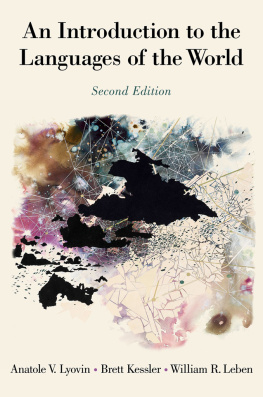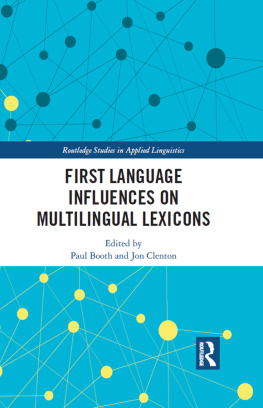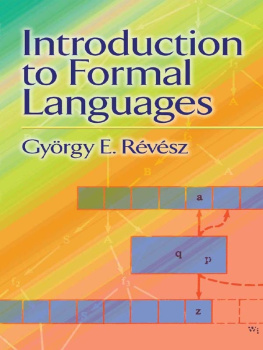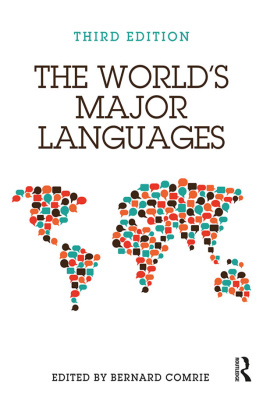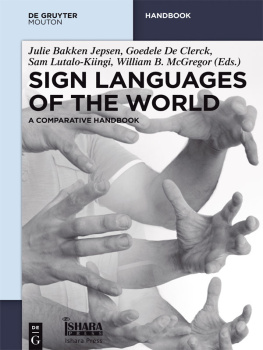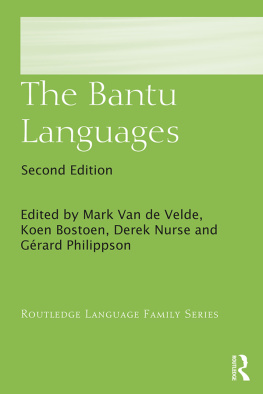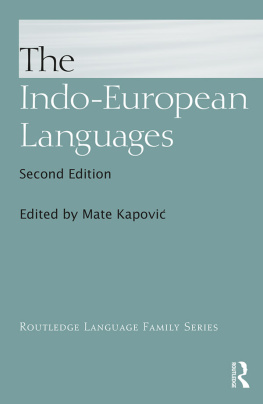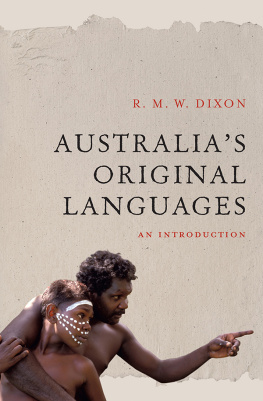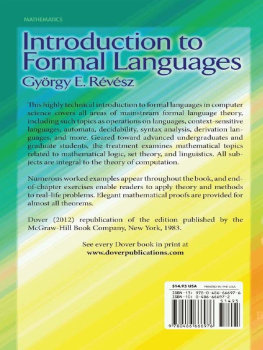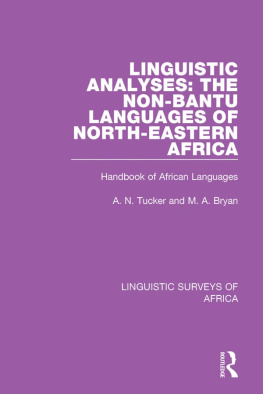An Introduction to the Languages of the World

Oxford University Press is a department of the University of Oxford. It furthers the Universitys objective of excellence in research, scholarship, and education by publishing worldwide. Oxford is a registered trade mark of Oxford University Press in the UK and certain other countries.
Published in the United States of America by Oxford University Press
198 Madison Avenue, New York, NY 10016, United States of America.
Oxford University Press 2017
First Edition published in 1997
Second Edition published in 2017
All rights reserved. No part of this publication may be reproduced, stored in a retrieval system, or transmitted, in any form or by any means, without the prior permission in writing of Oxford University Press, or as expressly permitted by law, by license, or under terms agreed with the appropriate reproduction rights organization. Inquiries concerning reproduction outside the scope of the above should be sent to the Rights Department, Oxford University Press, at the address above.
You must not circulate this work in any other form and you must impose this same condition on any acquirer.
Library of Congress Cataloging-in-Publication Data
Names: Lyovin, Anatole, author. | Kessler, Brett, 1956 author. | Leben, William Ronald, 1943 author.
Title: An introduction to the languages of the world / Anatole V. Lyovin, Brett Kessler, William R. Leben.
Description: Oxford ; New York : Oxford University Press, [2017] | Includes bibliographical references and index.
Identifiers: LCCN 2016033660 (print) | LCCN 2016041209 (ebook) | ISBN 9780195149883 (pbk. : alk. paper) | ISBN 9780190645267 (pdf) | ISBN 9780190645274 (ebook) | ISBN 9780190662752 (online resource)Subjects: LCSH: Language and languages. | Linguistics.
Classification: LCC P371 .L96 2017 (print) | LCC P371 (ebook) | DDC 410dc23 LC record available at https://lccn.loc.gov/20160336
PREFACE
Preface to the first edition
This book is intended to be used in a course designed for students who have mastered the basic principles of linguistics but lack background information about the broad range of language phenomena (vowel harmony, ergative constructions, etc.) found in the worlds languages, and who also need to learn a few facts about the existence of major language families, the distribution of major language groups, and so forth. It aims to offer students an opportunity to explore, at various levels, structures of very different, highly interesting languages without necessarily possessing a speaking or reading knowledge of these languages, as they would in normal language classes. At the same time, this book can serve as an introduction to language typology in general.
It should be emphasized that this text is not intended as an introduction to linguistics, since it presupposes some familiarity with such basic linguistics concepts as morpheme, phoneme, and basic articulatory phonetics terms. It is intended as a textbook for undergraduates who have already taken at least one advanced course in general linguistics and may also have taken an introductory course in phonetics. It is also intended for graduate students in linguistics who have already taken their required introductory courses in various branches of linguistics but otherwise have little background knowledge of the field. At the University of Hawaii at Mnoa, for example, a course for which this work would be assigned as a textbook requires as a minimum prerequisite an upper-division introductory course in general linguistics, which beginning graduate students who have no background in linguistics are required to take. Naturally, students who have had other linguistics courses (e.g. phonetics, phonology, and syntax) usually enjoy this course more and encounter fewer difficulties.
Even though this book is not intended as an introductory text in linguistics, certain concepts are reviewed in some detail in the introductory chapter because my experience as a teacher of beginning linguistics students has taught me to expect all sorts of misconceptions about what linguists mean when they say that certain languages are genetically related. It is also not intended as a reference book, since it is limited in scope and coverage and certainly cannot compete with such books as Bernard Comries The Worlds Major Languages (New York: Oxford University Press, 1987), which contains in-depth articles on major languages and language families written by recognized experts in their respective fields. Lacking expertise in all the languages of the world, I have had to depend on the opinions of others without always being able to check the validity and accuracy of the latter. On the other hand, reference works are usually too technical and contain too many details for beginning students. In addition, they are not ideal as textbooks because, among other things, they do not contain such things as exercises and other addenda helpful to the instructor as well as students in introductory-level classes.
The need for such a textbook became apparent about twenty years ago, when I began teaching a course on the languages of the world and found that there were simply no suitable textbooks for such courses, despite the existence of several books entitled Languages of the World. (Most such books deal only with different writing systems found throughout the world.) It is only in recent years that up-to-date reference books on the languages of the world have appeared that are suitable to be placed on the reserve shelf for courses on the subject.
This book surveys all the areas of the globe on a continent-by-continent basis. It does not concentrate on major languages, although most of the languages in the sketches may be considered so. Some languages were chosen because of their typological interest and not the socioeconomic prominence of their speakers. However, not all language types are represented. This would have required that the scope of this textbook be greatly expanded; as it is, it would be too difficult to cover the entire contents adequately in one semester. It would probably be best for the instructor to choose, on the basis of the interests of the students, which language sketches to assign and which to skip. It is hoped that students will read independently any materials not formally covered during the course.
The coverage is not intended to be encyclopedic and exhaustive because there exist many excellent reference sources that may be consulted by students wishing to know more details about classification of particular languages, geographical distribution of languages, and the number of speakers of individual languages. My aim has been to strike a balance between overwhelming the readers with too much detailed information about various languages and the controversies involving their genetic classification, and giving too superficial an account. To make the account simpler and shorter, the coverage emphasizes the living languages rather than the extinct ones, although on occasion references are made to extinct languages as well. At the end of each chapter, there is a bibliography which will provide a good basis for readers who want to know more about some specific topic.
As for the controversial topics that have stirred the linguistic community in the recent and not-so-recent past, I felt that it would be highly remiss to avoid any mention of Joseph Greenbergs Amerind and Indo-Pacific hypotheses, Paul Benedicts Austro-Tai and Austro-Tai-Japanese hypotheses, and the Nostratic hypothesis being championed by Vitaly Shevoroshkin and colleagues. In the case of the Altaic hypothesis, which already has a venerable history and cannot be considered a recent development, it seemed a disservice to the readers to dismiss the whole matter with a mere mention in a footnote. Thus, all of these ideas are mentioned and briefly described in this text, and bibliographical references are given for scholarly articles that argue both for and against these hypotheses. On the other hand, since this is, after all, an introductory textbook, it would be out of place to include lengthy accounts of such controversies.

